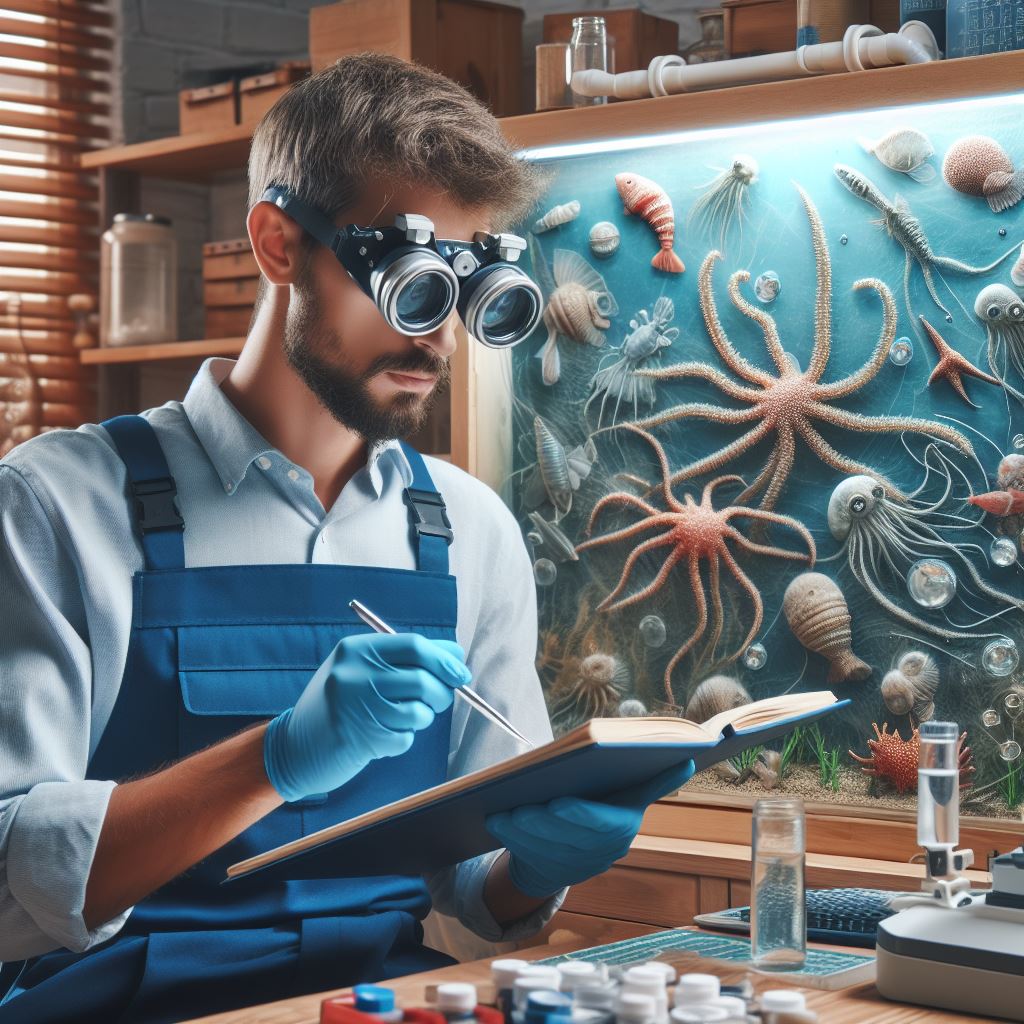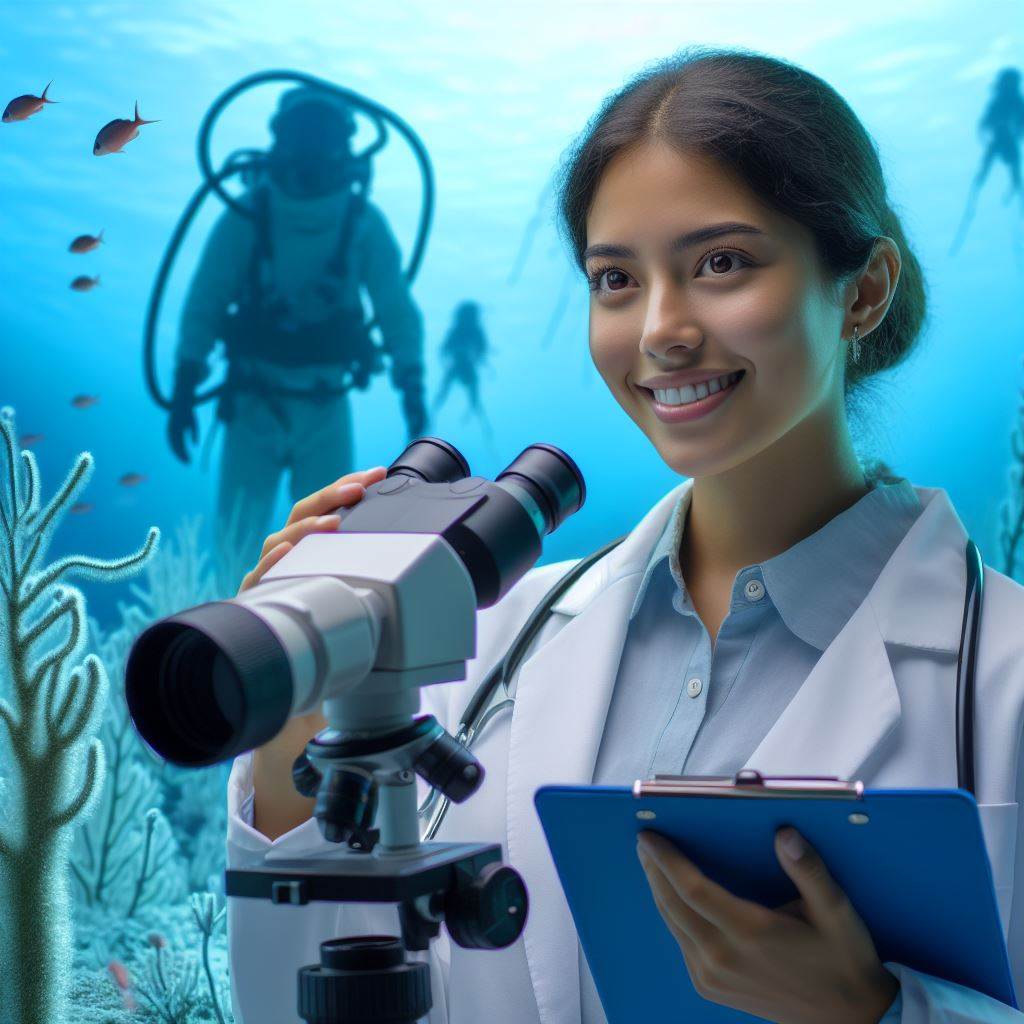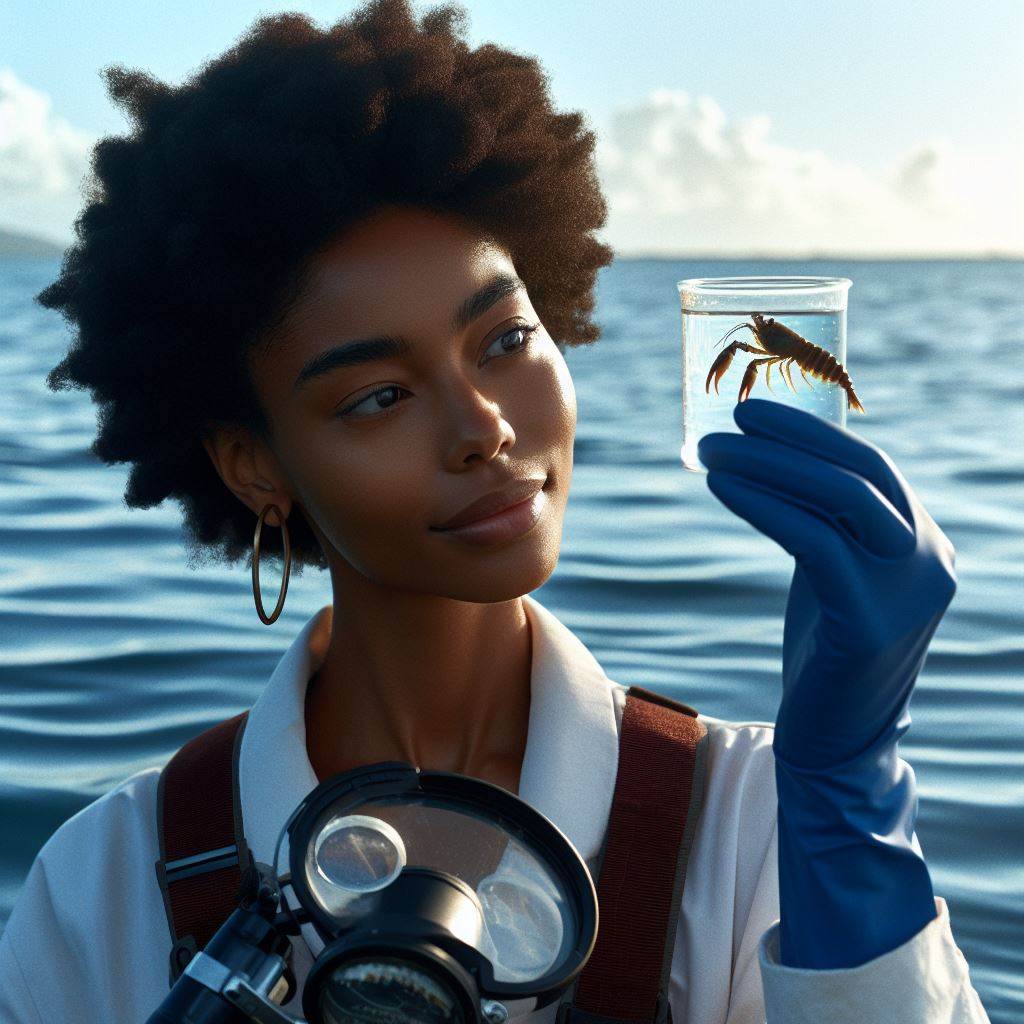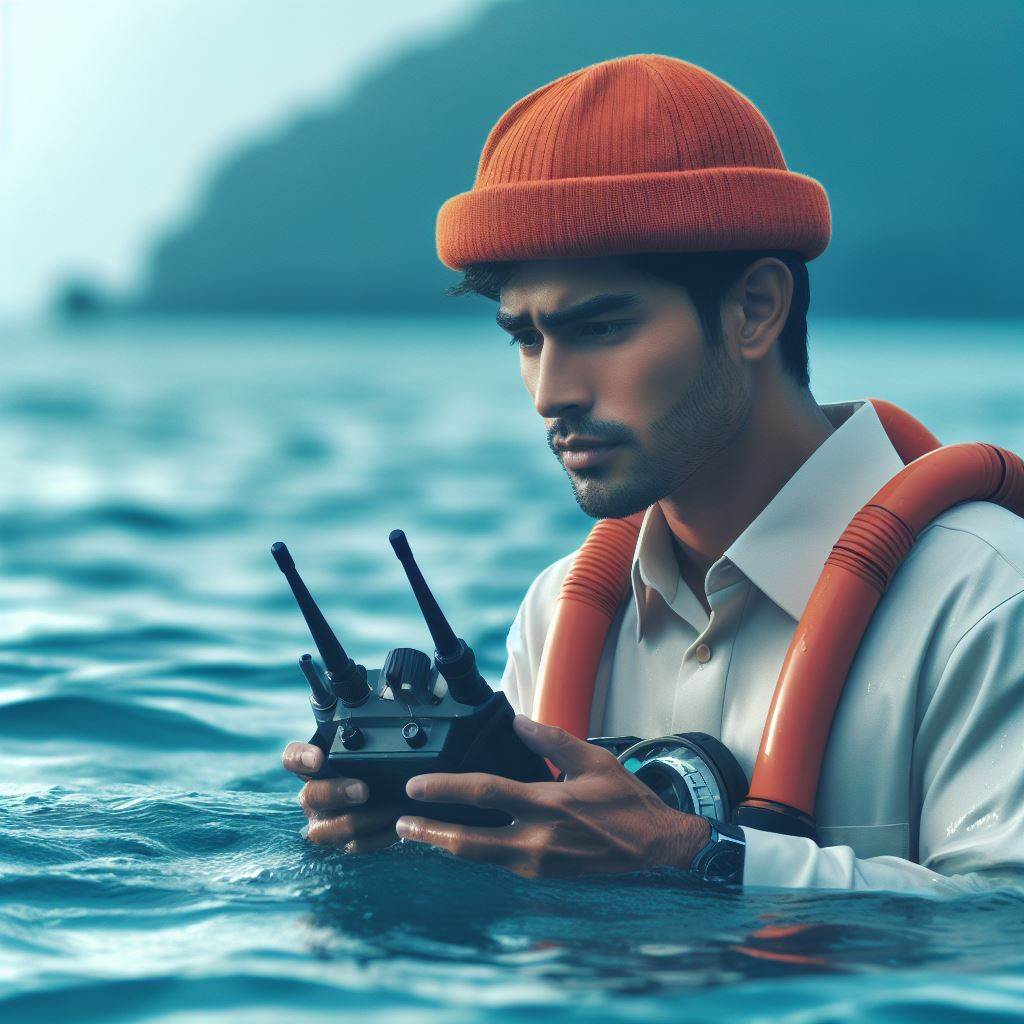Introduction
Marine biology is the study of marine organisms and their environment, playing a crucial role in understanding and conserving our oceans.
Technological advancements have greatly contributed to the progress of marine biology, allowing scientists to explore and comprehend marine ecosystems like never before.
Focus of the blog post
In this blog post, we will delve into the exciting new developments in marine biology technology in New Zealand.
New Zealand has long been at the forefront of marine research, with its extensive coastline and diverse marine life.
The country’s commitment to innovation has led to the emergence of groundbreaking technologies in the field of marine biology.
These advancements enable scientists to collect more accurate data, conduct in-depth studies, and effectively conserve marine resources.
One notable development is the use of unmanned underwater vehicles (UUVs) for marine research.
These autonomous robots can be equipped with various sensors and instruments to collect data on water quality, temperature, and marine life behavior.
UUVs allow scientists to reach remote and hazardous underwater locations where humans cannot venture, expanding the scope of marine research.
Another exciting technology is genetic analysis, which has revolutionized our understanding of marine biodiversity.
With the advent of DNA sequencing techniques, scientists can now identify and classify species more accurately.
This enables effective conservation efforts and sheds light on the intricate relationships within marine ecosystems.
Additionally, the use of satellite remote sensing has significantly improved the monitoring and management of marine environments.
Satellite imagery can track ocean temperatures, detect harmful algal blooms, and help predict the movement of marine species.
This data aids in decision-making processes related to fishing, conservation, and protection of marine habitats.
Personalized Career Consulting
Unlock your potential with expert career advice tailored to your goals. Get personalized guidance and actionable steps toward your dream career in New Zealand.
Get StartedIn essence, technological advancements have propelled marine biology research in New Zealand to new heights.
From unmanned underwater vehicles to genetic analysis and satellite remote sensing, these innovative tools have enhanced our understanding and management of marine ecosystems.
The continued development and application of technology in this field will undoubtedly play a vital role in ensuring the sustainability of our oceans for future generations.
Underwater Drones and Remote Sensing
How underwater drones are used in marine biology research
Underwater drones have revolutionized marine biology research, allowing scientists to explore previously inaccessible areas.
These advanced technological marvels are equipped with cameras and sensors, enabling researchers to observe and collect data from the ocean depths.
How New Zealand researchers are utilizing underwater drones
New Zealand researchers have embraced the use of underwater drones in various marine biology studies.
For instance, they use drones to identify and monitor marine species, such as whales and dolphins.
By capturing high-definition images and videos, researchers can obtain valuable information about the behavior and population dynamics of these animals.
In addition to species monitoring, underwater drones are used to assess the health of marine ecosystems.
By collecting water samples and analyzing them for pollutants and other environmental factors, researchers can gain insights into the overall health of an ecosystem.
This information helps in the conservation and management of marine resources.
Benefits of remote sensing technology in marine biology studies
One of the most significant advantages of underwater drones is their ability to conduct remote sensing.
Remote sensing is a technology that allows researchers to gather data without physical contact with the object of study.
In the context of marine biology, remote sensing involves the collection and interpretation of data acquired from drones to study various aspects of the marine environment.
Transform Your Career with a Professional CV and Cover Letter
Stand out to employers with an ATS-optimized resume and tailored cover letter designed to match your dream role. Let us craft your job application materials for success!
Get StartedSpecific research projects in New Zealand incorporating remote sensing technology
Remote sensing technology has revolutionized marine biology studies in New Zealand.
For example, researchers are using drones equipped with thermal imaging cameras to study the distribution and behavior of marine mammals.
By analyzing the heat signatures detected, scientists can understand their movement patterns, breeding grounds, and feeding behaviors.
Another research project in New Zealand incorporates remote sensing technology to study the impact of climate change on coral reefs.
Underwater drones are used to capture images and video footage of coral reefs, which are later analyzed to assess their health and resilience.
This technology allows scientists to monitor changes in coral reefs over time and develop strategies for their conservation.
In addition to capturing images and videos, underwater drones are equipped with sensors that can measure various parameters of the marine environment.
For instance, they can measure temperature, salinity, and nutrient levels, providing valuable data for understanding the dynamics of marine ecosystems.
The use of underwater drones and remote sensing technology has opened up new possibilities in marine biology research in New Zealand.
These advanced tools enable researchers to study marine organisms and their habitats in unprecedented detail.
By collecting data from remote and inaccessible areas, scientists can gain valuable insights into the marine world and contribute to its conservation.
As technology continues to advance, it is likely that underwater drones will play an increasingly important role in marine biology research.
With their ability to explore vast ocean depths and collect valuable data, these drones are changing the way we study and understand the marine environment.
Underwater drone technology will shape marine biology’s future in New Zealand and globally. Its development and use are crucial.
Boost Your Career with a Standout LinkedIn Profile
Attract recruiters and expand your network with a fully optimized LinkedIn profile tailored to highlight your strengths and professional goals. Let your profile open doors to new opportunities!
Get OptimizedRead: Ocean Conservation: NZ’s Role & Careers
DNA Sequencing
Overview of DNA sequencing and its application in marine biology
In the field of marine biology, DNA sequencing plays a crucial role in understanding and exploring the biodiversity of marine ecosystems.
This advanced technology allows scientists to analyze and decode the genetic information present in marine organisms.
New Zealand’s contribution to DNA sequencing advancements
New Zealand has made significant contributions to DNA sequencing advancements, furthering our knowledge of marine life in the region.
Researchers in New Zealand have been using DNA sequencing techniques to study various aspects of marine biology and uncover novel insights.
Specific research studies using DNA sequencing to understand marine biodiversity in New Zealand
One prominent study conducted in New Zealand involves the use of DNA sequencing to understand the biodiversity of marine species.
By analyzing the genetic information of different organisms, scientists can identify and classify species more accurately, even those that may appear similar visually.
This research has led to the discovery of numerous overlooked marine species.
Additionally, DNA sequencing has been instrumental in identifying and tracking the movement of marine species, such as whales and dolphins.
By analyzing the genetic markers present in their DNA, researchers can determine their migration patterns and better understand their behavior and population dynamics.
Impact of DNA sequencing technology on marine conservation efforts
The impact of DNA sequencing technology goes beyond discovering new species and studying migration patterns.
It plays a significant role in marine conservation efforts by providing crucial information for the development of conservation strategies and policies.
For instance, DNA sequencing has helped in identifying and monitoring endangered species in New Zealand’s waters.
By analyzing the genetic profiles of different populations, scientists can assess their health, genetic diversity, and overall population size.
This information is essential for developing targeted conservation plans to preserve these vulnerable marine species.
Furthermore, DNA sequencing has aided in identifying invasive species that can disrupt marine ecosystems.
By analyzing their DNA, scientists can determine the origin of these invasions and take necessary measures to prevent further spread, thus protecting native marine life.
Another area where DNA sequencing has shown immense potential is in the study of microbial communities in marine environments.
These microscopic organisms play a vital role in the overall health and functioning of marine ecosystems.
DNA sequencing allows scientists to study the genetic diversity and interactions of these microbes, providing valuable insights into their ecological roles.
In fact, DNA sequencing technology has revolutionized the field of marine biology.
New Zealand has made notable contributions to this field through various research studies focusing on marine biodiversity and conservation efforts.
By unraveling the genetic information concealed within marine organisms, scientists can better understand and protect these diverse ecosystems.
Read: NZ Marine Life: A Biologist’s Perspective

Satellite Tracking and Telemetry
In recent years, satellite tracking technology has revolutionized the field of marine biology research in New Zealand.
By using this innovative technology, scientists are able to monitor and gain valuable insights into the lives of marine animals.
Let’s explore how satellite tracking and telemetry are used, some notable projects in New Zealand, and the potential future applications.
How Satellite Tracking Technology is Used
Satellite tracking involves attaching small satellite tags to marine animals such as whales, seals, and turtles.
These tags transmit signals to orbiting satellites, allowing scientists to retrieve location data in real-time.
This technology enables researchers to study migration patterns, behavior, and habitat usage of these animals.
For instance, in New Zealand, satellite tags have been crucial in tracking the movements of endangered species like the New Zealand sea lion.
By monitoring their movements, scientists gain a deeper understanding of their feeding habits, breeding grounds, and migration routes.
This information is essential for designing effective conservation strategies.
Examples of Satellite Tracking Projects in New Zealand
New Zealand has been at the forefront of satellite tracking research in marine biology.
One notable project is the tracking of yellow-eyed penguins, an endemic species facing significant threats.
By attaching satellite tags to these penguins, scientists have discovered their foraging areas and migratory paths, enabling better protection measures.
Another remarkable project focuses on the tracking of humpback whales during their annual migration to New Zealand waters.
Satellite data has revealed their preferred route, which aids in avoiding areas with high levels of shipping traffic.
This information supports efforts to mitigate collisions between whales and vessels.
The Valuable Insights Gained from Satellite Tracking
Satellite tracking has provided unprecedented insights into the behavior and ecology of marine animals, contributing to marine conservation efforts.
By understanding migration routes and movements, researchers can identify critical habitats and propose marine protected areas that ensure the preservation of vulnerable species.
Furthermore, this technology offers insights into the impacts of climate change on marine ecosystems.
Scientists track ocean features and animal responses, detecting environmental changes and assessing species resilience, aiding adaptation strategies.
Potential Future Developments and Applications
The future of satellite telemetry in New Zealand’s marine biology sector looks promising.
Advancements in tag miniaturization and battery life allow deploying smaller, sophisticated tags on various species, gathering comprehensive data.
Moreover, the integration of satellite tracking with other technologies like drones and underwater gliders holds immense potential.
These complementary tools can provide a multi-faceted perspective on marine animal behavior, enabling researchers to gather a more holistic understanding of their lives under the sea.
Additionally, as satellite data transmission improves, real-time tracking will become even more accurate and accessible.
This will facilitate rapid response efforts during emergency situations such as oil spills or entanglements, as accurate and up-to-date information is crucial for effective decision-making.
Satellite tracking and telemetry technology have revolutionized marine biology research in New Zealand.
Through its application, scientists have gained valuable insights into the behavior, ecology, and conservation needs of marine animals.
With ongoing advancements, the future of satellite telemetry holds great promise for further enhancing our understanding of marine ecosystems and ensuring their long-term preservation.
Read: Top NZ Marine Research Breakthroughs
Autonomous Underwater Vehicles (AUVs)
Autonomous Underwater Vehicles (AUVs) are playing a crucial role in marine biology research.
These unmanned vehicles are capable of conducting surveys and collecting data in the underwater environment.
New Zealand has been actively involved in developing and utilizing AUVs for marine biology studies.
Let’s explore the examples of how AUVs are being used for marine biodiversity surveys in New Zealand and discuss their advantages and limitations.
1. Introduction to AUVs and their role in marine biology research
AUVs are remote-controlled or autonomous vehicles that can navigate underwater without the need for direct human intervention.
Various sensors and instruments gather data on marine ecosystems, including water quality, temperature, salinity, and biodiversity.
AUVs play a crucial role in studying marine ecosystems that are difficult to access or too dangerous for humans.
2. New Zealand’s involvement in developing and utilizing AUVs
New Zealand, with its extensive coastline and rich marine biodiversity, has recognized the potential of AUVs in marine research.
The country has been actively involved in developing and utilizing AUV technology for studying its unique marine ecosystems.
Researchers, government agencies, and conservation organizations collaborate to deploy AUVs in different locations, including coastal areas, offshore islands, and marine reserves.
3. Examples of AUVs being used for marine biodiversity surveys in New Zealand
AUVs in New Zealand are utilized for various marine biodiversity surveys.
They assess coral reef health, track marine species distribution, and investigate human impact on coastal ecosystems.
AUVs equipped with advanced imaging systems can capture high-resolution images and videos of underwater habitats, providing valuable data for biodiversity assessments.
AUVs actively map seafloor habitats, monitor endangered species, and study climate change effects.
These unmanned vehicles offer a non-invasive approach to gather data, minimizing disturbance to fragile habitats and species.
4. Advantages and limitations of AUV technology in marine biology studies
AUV technology offers several advantages in marine biology studies.
They can operate in remote and challenging environments, reaching depths that are beyond the capabilities of divers.
AUVs are cost-effective compared to manned submersibles and allow for extended data collection periods without the limitations of human endurance.
Moreover, they collect data consistently, eliminating potential human biases.
However, AUV technology also has limitations. They are limited by their battery capacity and operating range.
AUVs have to be programmed in advance, limiting real-time control and adaptability during data collection. Maintenance and deployment can also be complex and require specialized expertise.
Additionally, the processing and analysis of the massive amount of data collected by AUVs pose challenges.
In general, AUVs have revolutionized marine biology research in New Zealand by providing a versatile and effective means to study the underwater environment.
With their ability to collect high-quality data and navigate challenging terrains, AUVs have become an essential tool for understanding and conserving marine biodiversity.
As technology advances, it is likely that AUVs will continue to play an increasingly significant role in marine biology studies worldwide.
Read: Marine Biology Degrees in NZ Explained
Internet of Things (IoT) for Marine Monitoring
The Internet of Things (IoT) has revolutionized various industries, and marine biology is no exception.
IoT devices have become a significant tool in marine monitoring and research, enabling scientists to gather real-time data and make informed decisions.
New Zealand has been at the forefront of deploying IoT devices for marine biology studies, showcasing innovative initiatives that enhance data collection, analysis, and contribute to sustainable marine practices.
How IoT devices are utilized in marine monitoring and research
Marine monitoring and research employ IoT devices, gathering data on water parameters and marine life movements.
These devices are equipped with sensors that gather information and transmit it wirelessly to onshore laboratories or data centers.
By leveraging IoT technology, scientists can access critical information remotely, reducing the need for physical presence in the research area and minimizing disturbance to marine habitats.
New Zealand’s initiatives in deploying IoT devices for marine biology studies
New Zealand has made significant strides in deploying IoT devices for marine biology studies.
One notable initiative is the use of underwater drones equipped with IoT sensors.
These drones can collect data on water quality, marine life behavior, and habitat mapping.
Researchers can control the drones remotely and receive real-time data, allowing for timely interventions and informed decision-making.
Furthermore, New Zealand has installed a network of IoT buoys along its coastlines.
These buoys are equipped with various sensors and cameras that monitor environmental conditions and detect changes in marine ecosystems.
The data collected is then analyzed to identify patterns and trends, providing valuable insights into the health and dynamics of the marine ecosystem.
How IoT is improving data collection and analysis in marine biology research
IoT technology has greatly improved data collection and analysis in marine biology research.
Traditional methods often involve manual observation or sporadic data sampling, which may not provide a comprehensive understanding of marine ecosystems.
IoT devices gather high-resolution data, enabling scientists to identify trends, assess impacts, and predict scenarios.
Potential for IoT technology to contribute to sustainable marine practices in New Zealand
Moreover, IoT devices in marine monitoring have the potential to contribute to sustainable practices in New Zealand.
By collecting accurate and real-time data, scientists can better assess the health of marine ecosystems and take proactive measures to protect them.
For example, detecting fluctuations in water temperatures can help identify early signs of coral bleaching, prompting immediate actions to mitigate the damage.
Similarly, IoT devices can aid in the management of commercial fisheries.
By monitoring fish movements and stock levels, authorities can implement effective fishing regulations and prevent overfishing.
This technology also enables the tracking of marine vessels, ensuring compliance with regulations and reducing illegal fishing activities.
In review, IoT devices have transformed marine biology research and monitoring in New Zealand.
The innovative use of IoT sensors in underwater drones, buoys, and other devices has significantly enhanced data collection, analysis, and decision-making capabilities.
By harnessing IoT technology, New Zealand is leading the way in sustainable marine practices, ensuring the preservation and protection of its diverse marine ecosystems.
Conclusion
This blog post explored the latest technological advancements in marine biology in New Zealand.
We discussed the use of drones for marine research and conservation efforts, as well as the development of underwater robots for data collection.
Additionally, we highlighted the importance of staying updated with these new developments in order to improve our understanding of marine ecosystems and aid in conservation efforts.
The use of drones and underwater robots in marine biology has the potential to revolutionize the field in New Zealand.
These technologies allow for more efficient data collection and monitoring of marine environments, enabling scientists to gather valuable information and make informed decisions about conservation strategies.
By staying up-to-date with these advancements, researchers and conservationists can stay ahead of the curve and maximize their impact on protecting New Zealand’s marine biodiversity.
Furthermore, the implementation of these technologies can greatly enhance the effectiveness of marine conservation efforts.
With the ability to gather more accurate and extensive data, scientists can develop targeted conservation plans that address specific threats to marine ecosystems.
This can lead to more successful conservation outcomes and a healthier marine environment for future generations.
The advancements in marine biology technology discussed in this blog post have the potential to greatly benefit New Zealand’s marine biology sector and conservation efforts.
Embracing technologies and staying updated can help us understand and preserve marine ecosystems better.
Let us seize these opportunities and work towards a more sustainable and thriving future for our marine life.




